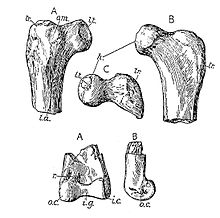Elopteryx
|
Elopteryx Temporal range: Late Cretaceous, 70 Ma |
|
|---|---|
 |
|
| The holotype femur fragment and referred tibiotarsus fragment in several views | |
| Scientific classification | |
| Kingdom: | Animalia |
| Phylum: | Chordata |
| Class: | Reptilia |
| Clade: | Dinosauria |
| Order: | Saurischia |
| Suborder: | Theropoda |
| Clade: | Maniraptora |
| Genus: |
†Elopteryx Andrews, 1913 |
| Type species | |
|
†Elopteryx nopcsai Andrews, 1913 |
|
Elopteryx is a genus of, perhaps troodontid, maniraptoran theropod dinosaur based on fragmentary fossils found in late Cretaceous Period rocks of Romania. The single species, Elopteryx nopcsai, is known only from very incomplete material, and therefore is considered a nomen dubium ("dubious name") by most paleontologists.
In the late nineteenth or early twentieth century, the famous Hungarian paleontologist Franz Nopcsa von Felső-Szilvás found near Sînpetru, in what is now the Romanian region of Transylvania, some bone fragments of a small theropod. These were acquired by the British Museum of Natural History. In 1913, curator Charles William Andrews named these as the type species Elopteryx nopcsai. The genus name Elopteryx is from Ancient Greek helos (ἕλος), "marsh" + pteryx (πτέρυξ), "wing". The specific name honors Nopcsa. Initially, Elopteryx was described from its holotype, a proximal left femur, specimen BMNH A1234. A second upper left thighbone fragment, BMNH A1235, was referred. A distal left tibiotarsus was also tentatively assigned to this taxon; it was initially classified with the same specimen number as the holotype and was found in close proximity, but may not be from the same individual (see below). This has since been relabeled and is now specimen BMNH A4359. The exact location and time of the discoveries are today unknown. The fossils date from the early-late Maastrichtian (Begudian) faunal stage, circa 71-66 million years ago, originating from the Sânpetru Formation of the Hațeg Island. The animal was by Andrews believed to be a pelecaniform seabird.
...
Wikipedia
